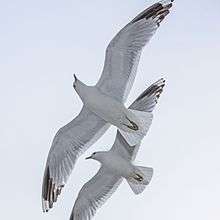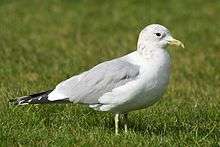Common gull
- For the common gull butterfly, see Cepora nerissa.
| Common gull | |
|---|---|
 | |
| Adult mew gull. Anchorage Coastal Wildlife Refuge, Alaska. | |
| Scientific classification | |
| Kingdom: | Animalia |
| Phylum: | Chordata |
| Class: | Aves |
| Order: | Charadriiformes |
| Family: | Laridae |
| Genus: | Larus |
| Species: | L. canus |
| Binomial name | |
| Larus canus Linnaeus, 1758 | |
The common gull (Larus canus) is a medium-sized gull which breeds in northern Asia, northern Europe and northwestern North America. The North American subspecies is commonly referred to as the mew gull, although that name is also used by some authorities for the whole species.[2] It migrates further south in winter.[3] There are differing accounts as to how the species acquired its vernacular name (see Etymology section below).
Description


Adult common gulls are 40–46 cm (16–18 in) long, noticeably smaller than the herring gull and slightly smaller than the ring-billed gull. It is further distinguished from the ring-billed gull by its shorter, more tapered bill, which is a more greenish shade of yellow and is unmarked during the breeding season. The body is grey above and white below. The legs are greenish-yellow. In winter, the head is streaked grey and the bill often has a poorly defined blackish band near the tip, which is sometimes sufficiently obvious to cause confusion with ring-billed gull. They have black wingtips with large white "mirrors". Young birds have scaly black-brown upperparts and a neat wing pattern, and grey legs. They take two to three years to reach maturity. The call is a high-pitched "laughing" cry.[3][4]
Taxonomy
There are four subspecies, two of which are considered distinct species by some authorities:[3][5]
- L. c. canus – Linnaeus, 1758 – common gull. nominate, found in Europe and western Asia. Small; mantle medium grey (palest subspecies); wingtips with extensive black; iris dark. Wingspan 110–125 cm (43–49 in); mass 290–480 g (10–17 oz).
- L. c. heinei – Homeyer, 1853 – Russian common gull. Found in central northern Asia. Medium size; mantle dark grey (darkest subspecies); wingtips with extensive black; iris dark. Mass 315–550 g (11.1–19.4 oz).
- L. c. kamtschatschensis – Bonaparte, 1857; syn. L. kamtschatschensis – Kamchatka gull. Found in northeastern Asia. Large; mantle medium-dark grey; wingtips with extensive black; iris pale. Mass 394–586 g (13.9–20.7 oz).
- L. c. brachyrhynchus – Richardson, 1831; syn. L. brachyrhynchus – mew gull or short-billed gull. Found in Alaska and western Canada. Small; mantle medium-dark grey; wingtips with little black and much white; iris pale. Wingspan 96–102 cm (38–40 in); mass 320–550 g (11–19 oz).
Ecology
Both common and mew gulls breed colonially near water or in marshes, making a lined nest on the ground or in a small tree; colony size varies from 2 to 320 or even more pairs. Usually three eggs are laid (sometimes just one or two); they hatch after 24–26 days, with the chicks fledging after a further 30–35 days. Like most gulls, they are omnivores and will scavenge as well as hunt small prey. The global population is estimated to be about one million pairs; they are most numerous in Europe, with over half (possibly as much as 80-90%) of the world population.[6] By contrast, the Alaskan population is only about 10,000 pairs.[3]

Vagrancy
The common gull occurs as a scarce winter visitor to coastal eastern Canada and as a vagrant to the northeastern USA.[7] There is one recent record of a mew gull in Europe, on the Azores in 2003.[8]
Etymology
The scientific name is from Latin. Larus appears to have referred to a gull or other large seabird, and canus is "grey".[9] The name "common gull" was coined by Thomas Pennant in 1768 because he considered it the most numerous of its genus.[10] Others assert that the name does not indicate its abundance, but that during the winter it feeds on common land, short pasture used for grazing.[11] John Ray earlier used the name common sea-mall.[10] It is said that uncommon gull is a more accurate description. There are many old British regional names for this species, typically variations on maa, mar and mew.[12]
References
- ↑ BirdLife International (2015). "Larus canus". IUCN Red List of Threatened Species. IUCN. 2015: e.T22694308A85045850. Retrieved 1 May 2016.
- ↑ Gill, F.; Donsker, D., eds. (2016). "IOC World Bird List (v 6.2)". IOC World Bird List. doi:10.14344/IOC.ML.6.2.
- 1 2 3 4 del Hoyo, J.; Elliot, A.; Sargatal, J., eds. (1998). Handbook of the Birds of the World. 3. Barcelona: Lynx Edicions. p. 621. ISBN 84-87334-20-2.
- ↑ Snow, D.W.; Perrins, C.M. (1998). The Birds of the Western Palearctic (Concise ed.). Oxford University Press. ISBN 0-19-854099-X.
- ↑ Olsen, K.M.; Larsson, H. (2004). Gulls of Europe, Asia and North America. Helm. ISBN 0-7136-7087-8.
- ↑ Hagemeijer, W.J.M.; Blair, M.J., eds. (1997). The EBCC Atlas of European Breeding Birds. London: Poyser. ISBN 0-85661-091-7.
- ↑ Sibley, David Allen (2000). The Sibley Guide to Birds. New York: Knopf. p. 483. ISBN 0-679-45122-6.
- ↑ Alfrey, P.; Ahmad, M. (2007). "Short-billed Gull on Terceira, Azores, in February–March 2003 and identification of the 'Mew Gull complex'". Dutch Birding. 29 (4): 201–212.
- ↑ Jobling, James A (2010). The Helm Dictionary of Scientific Bird Names. London: Christopher Helm. pp. 89, 219. ISBN 978-1-4081-2501-4.
- 1 2 Lockwood, W.B. (1993). The Oxford Dictionary of British Bird Names. Oxford University Press. ISBN 978-0-19-866196-2.
- ↑ Okill, Dave (2004). "English names for Western Palearctic birds". British Birds. 97 (7): 348–349.
- ↑ Jackson, Christine E. (1968). British Names of Birds. Witherby. ISBN 978-0854930043.
External links
| Wikimedia Commons has media related to Larus canus. |
| Wikispecies has information related to: Larus canus |
- BirdLife species factsheet for Larus canus
- "Larus canus". Avibase.

- "Mew Gull media". Internet Bird Collection.
- Mew Gull photo gallery at VIREO (Drexel University)
- Interactive range map of Larus canus at IUCN Red List maps
- Audio recordings of Mew gull on Xeno-canto.
- Larus canus in the Flickr: Field Guide Birds of the World
- Common gull media at ARKive

